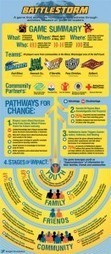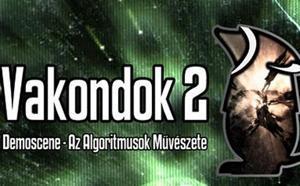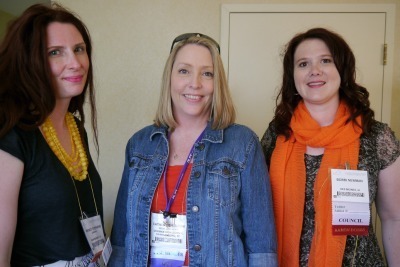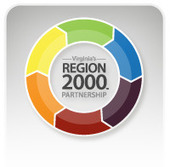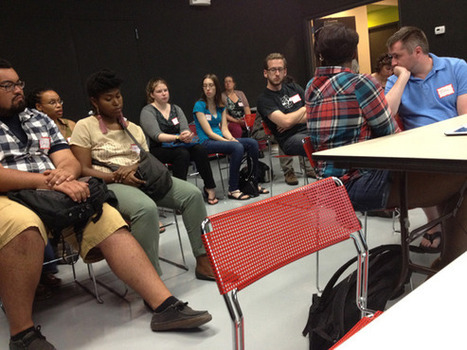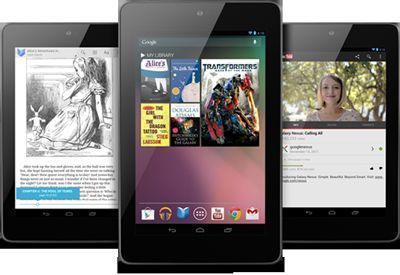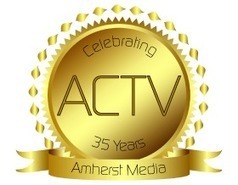 Your new post is loading...
 Your new post is loading...
"This is the new public art. Not bronze statues of dead white guys or static plop art, but dynamic media art that reflects the city and the time we live in, and give the energy of the city back to us. "Digital displays the size of buildings, wearable computers the size of t-shirt logos, and every programmable surface in between are becoming the new canvas for artistic expression. Boston Cyberarts is bringing media art to two urban screens in downtown Boston, taking our city to the forefront of the artistic use of large urban screens. At the Boston Convention Center, 17 art projects play in rotation with convention information and advertising, and at the Harbor Island Pavilion on the Rose Kennedy Greenway, computer artists will generate real-time, constantly changing imagery to visualize data the National Park Service has collected from the harbor for 20 years. Click headline to read more and watch George Fifield's presentation--
In an increasingly visual culture, the old ways of communicating lessons learned are startlingly out of touch with how we want and expect to get information. That’s why the John S. and James L. Knight Foundation decided to try a new approach to sharing lessons they were learning from the evaluation of two social impact games. One game, Battlestorm, was a youth-based game to improve hurricane preparation awareness and habits on the Gulf Coast. The other, Macon Money, used an alternative form of local currency to connect residents to each other and to attract and expose people to local businesses in Macon, Georgia. For both evaluations, the foundation wanted to communicate its findings in ways that were just as appealing, interactive, and forward-thinking as the games themselves. Hershey Cause Communications led the evaluation team and produced a suite of interactive data visualizations, infographics, PowerPoints and publications to communicate the results. The idea was to communicate the findings in real-time over the course of the games and again when the final analysis was complete. For more details, check out what popular philanthropy blogger, Lucy Bernholz, recently called “… the most fun evaluation report you’ve ever seen.” Or in keeping with the idea that visuals can sometimes say more than words, you can experience the website here and via the links mentioned below. We learned two key lessons from this process of combining evaluation and communications to share valuable information: Click headline to read more and access hot links--
NTEN aspires to a world where all nonprofit organizations use technology skillfully and confidently to meet community needs and fulfill their missions. We are the membership organization of nonprofit technology professionals. Our members share the common goal of helping nonprofits use all aspects of technology more effectively. We believe that technology allows nonprofits to work with greater social impact. We enable our members to strategically use technology to make the world a better, just, and equitable place. NTEN facilitates the exchange of knowledge and information within our community. We connect our members to each other, provide professional development opportunities, educate our constituency on issues of technology use in nonprofits, and spearhead groundbreaking research, advocacy, and education on technology issues affecting our entire community. Click headline to access NTEN's website--
After recently attending the latest in the never-ending series of “future of journalism” conferences, I finally realized why they all fail: They don’t include the right people. While these well-intended yakfests are rich in whining and dining ops, journo-futuramas generate few practical or actionable ideas because they lack the perspectives of four key constituencies: ∷ Consumers – The actual people who not only consume journalism but evidently will create growing amounts of it in the future. ∷ Technologists – The actual people who are creating the platforms on which consumers will get and give information in the future. ∷ Marketers – The actual people whose advertising purchases historically underwrote journalism and, given the right sorts of products and services, might continue to do so in the future. ∷ Investors – The actual people who could bankroll innovative commercial or non-profit ventures to sustain journalism in the future. Instead of bringing together these diverse and strategically vital stakeholders, the usual journo-futurama is composed largely of white, middle-aged newspapermen (or, more likely, former newspapermen) who came up in the day when cold type was the hot new technology. Click headline to read more--
As the Minnesota Intelligent Rural Communities (MIRC) initiative winds down, demonstration communities are taking time to reflect on what has happened in their community as a result of added focus on broadband and broadband projects in the area. Each community will go through this process looking at what’s happened, lessons learned and plans for the future. One of the public benefits of federal funding for a project link this is the opportunity each community has to share what they have learned and the opportunity that other communities have to glean from their lessons. And so today I’m pleased to share notes from Windom (Actually I have notes to share all week. I’ll add this preamble to each for historical context – but each day will be a new community.) Here are the highlights from Winona… Click headline to read more--
The Knight Commission on the Information Needs of Communities in a Democracy was a blue ribbon panel of seventeen media, policy and community leaders that met in 2008 and 2009. Its purpose was to assess the information needs of communities, and recommend measures to help Americans better meet those needs. Its Report, Informing Communities: Sustaining Democracy in the Digital Age, was the first major commission on media since the Hutchins Commission in the 1940’s and the Kerner and Carnegie Commissions of the 1960’s. In the digital age, technological, economic and behavioral changes are dramatically altering how Americans communicate. Information is more fragmented. Communications systems no longer run along the same lines as local governance. The gap in access to digital tools and skills is wide and troubling. This new era poses major challenges to the flow of news and information people depend on to manage their complex lives. Click headline to access the Knight Commission website--
We will be hosting a Q&A at this showing with the director Lameron, and the emcee, Fantom! The demoscene is an electronic art subculture which began in Europe in the late nineteen-eighties, whose participants include programmers, graphic artists, animators, musicians, electrical engineers, and more. @party is a local demoscene event, or demoparty, a collaborative electronic art festival where people meet and participate in a variety of competitions which allow them to demonstrate their technical and artistic skills. In addition to competing, attendees at demoparties socialize, network, learn from each other, and sometimes collaborate onsite on last minute entries. Hungarian studio Flame Film recently completed a documentary intended to introduce people to the scene's remarkable technical accomplishments and productive artistic community. You can view the trailer and the opening sequence below. This is a montage from the beginning of the film which includes some memorable moments in demos over the history of the scene, presented in chronological order: Click headline to view the two video clips--
Advocating on behalf of its members is a priority for ISTE (the International Society of Technology in Education). But in a rapidly changing landscape overshadowed by a continually contracting economy, even large organizations must retool their strategy. In a press briefing at ISTE’s annual conference in San Diego, outgoing CEO Don Knezek and incoming ISTE CEO Brian Lewis discussed what’s ahead for the organization and specifically addressed library media specialists/school librarians, as well as the recent FCC proposal on digital literacy. Click headline to read more--
The recent death of Rodney King reminds us of many things, not least of which is how important technology can be in the pursuit of justice. The videotape of the beating of King by Los Angeles police in 1991 challenged our nation to take seriously claims from communities of color that they experience police brutality routinely. Fast forward to the 21st century and we can point to repeated examples where new forms of technology provide evidence in the brutal deaths of young black men-- Oscar Grant (cell phone video), Derrion Albert (cell phone video), and now Trayvon Martin (cell phone call). When Trayvon's parents wanted justice for their son they turned to new media, mounting an online petition through Change.org to pressure prosecutors to charge George Zimmerman with his death. Sadly, it seems we still need new media to aid in our pursuit of the killers of, in particular, young people of color. As the 2012 election approaches it is important to realize how young people, especially youth of color, are using new media to amplify their voices in the political realm. While we know Obama'a 2008 campaign used social media to reach and mobilize young voters, we are less familiar with innovative ways youth of color are circumventing political elites and engaging in a new form of politics called participatory politics. That's the term researchers in the MacArthur Foundation Research Network on Youth and Participatory Politics use to describe acts such as starting a political group online, circulating a blog about a political issue, or forwarding political videos to friends. Like traditional political acts they address issues of public concern. The difference is that participatory acts are interactive, peer-based, and do not defer to elites or formal institutions. They are also tied to digital or new media platforms that facilitate and amplify young people's actions. Click headline to read more--
Founded in late 2010 by Avichal Garg, Spool is a mobile application available on the App Store, which allows you to save video and other contents for future reference. Soon before the acquisition, Spool had informed users that their services were closed down and advised them to save their content directly to their devices and computers, or to other services. “We started Spool to make content easy to consume on a mobile device. To accomplish this, we built some very sophisticated technology and developed a deep expertise in mobile software development,” Spool said in a blog post on Saturday. “We are proud to announce that today we will be pursuing our vision as a part of Facebook.” It is also not clear whether Mark Zuckerberg will use the technology developed by Spool or if he’s simply recruiting the mobile team. Yet, it would seem that Zuckerberg is more interested in the skills of Spool’s developer to monetize mobile content rather than technology. While Spool is shutting down its innovative bookmarking service, users can check out alternatives to Spool to store their content. Although there are plenty of services available, apps like Pocket, Instapaper and Readability offer the closest in terms of functionality and usability. Click headline to read more and access hot links--
The Boston Cyberarts, their Special Projects, Axiom, ATNE & Festival, which is the first and largest collaboration of artists working in new technologies in all media in North America, encompassing visual arts, dance, music, electronic literature, web art, and public art. Click headline to access Boston Cyberarts' website--
The new millennium has ushered in an era of continually evolving technology, fast-paced communication, and the rise of opportunity – and power – among the historically disenfranchised. Few appreciate this phenomenon and all it means more than Lauren deLisa Coleman, socio-economic digital analyst, consultant, entrepreneur, and author of the e-book RISE OF THE SMARTPOWER CLASS: Navigating the New Digital, LeaderfulEra. In her e-book, Coleman detailed the importance of not just reading articles online, but reading the ensuing user-generated comments to gauge the uninhibited opinions of individuals and thus society as a whole. In Coleman’s words, “Comment sections are a fascinating place to witness the emerging attitudes of the modern era.” To deconstruct this phenomenon, Coleman analyzed news stories on everything from Kim Kardashian to last year’s near government shutdown in an effort to study the impact of the new digital age and the rise of what she has branded as the SmartPower class. According to Coleman, this class is “a specific and growing tribe of hip, young (though not exclusively) neo-humans who are self-determinant, socially conscious and use tech extensions to explore and express the creation of a new power dynamic.” Click headline to read more--
CMAP, Community Media Access Partnership, is a non-profit tax-exempt public, education and government access media center that serves Gilroy, Hollister and San Juan Baustista.Funding.
CMAP is a partnership with the communities that it serves, including Gavilan Community College. Although it is housed at Gavilan Community College, it is a separate non-profit organization.
Click headline to access CMAP's website--
|
Our kids will spend the rest of their lives in the future Are we getting them ready? Kevin Honeycutt (@kevinhoneycutt) - Hutchinson, Kansas Click headline to watch his presentation--
The Region 2000 Technology Council, Central Virginia Community College, Future Focus Foundation, and the school divisions of Amherst, Appomattox, Bedford, Campbell, and Lynchburg, along with area business partners are moving closer to launching a Career and Technical STEM (science, technology, engineering and math) Academy in our area. Dovetailing with current K-12 STEM activities and workforce development initiatives, the goal of this institution will be to help close the gap between education and industry, furthering the economic vitality of this region. Implementation of Governor’s CTE-STEM Academies in Virginia began under the Kaine administration in 2007. There are currently 14 approved STEM Academies in Virginia, many of which are the product of Governor McDonnell’s initiative to double the number of STEM Academies in Virginia by the end of his administration. This type of STEM Academy differs from the Regional Governor’s School for Science and Technology in the type of curriculum and courses offered. CTE-STEM Academy courses will have a career and technical education focus with the curriculum driven by the needs and projected growth of regional industry. Currently the two identified student pathways to be offered at the academy include healthcare and mechatronics; the latter being the blending of mechanical and electrical engineering disciplines. Click headline to read more--
The Department of Labor said that its almost 2,800 American Job Centers will start providing digital literacy outreach as part of the Federal Communications Commission/Obama Administration/broadband industry Connect2Compete initiative. That came in an announcement Monday at an employment center in Arlington, Va. FCC chairman Julius Genachowski joined Labor secretary Hilda Solis and others to unveil that new effort, as well as an early 2014 public service campaign through the Ad Council, which puts together pro bono creative with donated ad space and time from TV and radio stations. The campaign will promote a new database and training locator tool to help identify computing centers and training, which will be released this fall. As part of Monday's announcement, Connect2Compete released preliminary results from its San Diego pilot program offering $9.95-per-month standalone broadband and $150 laptops to households with school kids eligible for school lunch programs, where more families bought the service from Cox -- the participating cable provider -- during the two-month test than had been projected, according to the FCC. Click headline to read more--
What would you do if you thought you had a solution that would make a high-quality education freely available to anyone with a computer or cell phone, help instructors build new teaching skills and get credit for their accomplishments, and also greatly reduce costs for schools, families and students? You’d want to tell the world! That is just what the nearly one hundred videographers who entered the “Why Open Education Matters” video competition, co-sponsored by the U.S. Department of Education, spent part of this summer doing. Here are the top three winners: Click headline to view the videos--
When PIFVA (Philadelphia Independent Film and Video Association) put out the calls for a dialogue on creating a 2,100 square foot, three floor Media Arts Hub and coworking space, located over PhillyCAM’s office at 7th and Chestnut, Coordinating Director Caroline Savage was not sure how the organization would frame its role in the process or who would come to the conversation. But after the three floors buzzed with emerging and established media makers at two recent meetings, she embraced the potential for PIFVA’s catalytic role in the process. “My instinct right now is that PIFVA could be the driver based on mission and so much of the conversation was about projects, incubators, networking and sharing. All part of our mission. I see the ‘working professionals’ as a smaller contingent, not to be omitted, however. So, I feel that PIFVA will be involved in this development as a founder/leader,“ Savage said. The space at PhillyCAM will be the site of two upcoming trial sessions that are free to anyone interested in trying cowork. They'll be held on Wed., July 18 and Aug. 1 from 2-6 p.m. Click headline to read more--
More jobs these days require high level skills such as accessing information, solving problems and working collaboratively. These skills — along with communicating effectively and analyzing data and evidence — are highly relevant in the workplace and in the community, said Renee Hobbs, founder of the Media Education Lab at Temple University and professor in the School of Communications and Theater. "Today, the ability to be a knowledge worker is fundamental to the U.S. economy," she said. But today's students need training if they're going to become tomorrow's knowledge workers. In the white paper Digital and Media Literacy: A Plan of Action, Hobbs outlines 10 steps to strengthen digital and media literacy. The Aspen Institute commissioned the paper to move the digital and media literacy recommendations of the Knight Commission on the Information Needs of Communities in a Democracy from a plan into action. Click headline to read more and access hot link to white paper--
Our unique combination of exhibition space and production facilities provides a public forum for the development and discussion of artistic practices involving interactivity, networked and remote connection, and the interface of the physical and the virtual. We reach out to our members and public through our diverse programming, including: --Exhibitions --Hands-on workshops --Professional development workshops --Panel discussions --Artist talksInformal gatherings, a.k.a. Open Labs --Axon, our weekly e-newsletter Our programs support electronic art from conception and construction to exhibition and discussion. We explore the impact of technology on the social, political and cultural aspects of contemporary life and encourage audiences to see anew their relationships with interactive artworks. InterAccess is Ontario's only gallery and production facility devoted exclusively to electronic media art. Click headline to access InterAccess' website--
Tablets and smartphones -- and users' infatuation with them -- continue to pummel the PC market. Worldwide PC shipments were flat this past quarter, just like they were for the previous six quarters before that, according to a report out Wednesday from the research firm Gartner. PC shipments globally totaled 87.5 million units in the second quarter of 2012. That is a decline of 0.1 percent from the second quarter of the previous year. "In the second quarter of 2012, the PC market suffered through its seventh consecutive quarter of flat to single-digit growth," Mikako Kitagawa, principal analyst at Gartner, said in a written statement. "Uncertainties in the economy in various regions, as well as consumer's low interest in PC purchases, were some of the key influencers of slow PC shipment growth." Kitagawa noted that despite analysts' and PC makers' high expectations for ultrabooks, which are thin and light laptops with long battery life, not enough were sold in the second quarter of this year to have an impact on the market. Click headline to read more--
Google didn’t surprise anyone when it announced its $199 8GB Nexus 7 tablet in late June; rumors of the small slateleaked on a weekly basis for months prior. What may surprise many consumers, however, is the overall experience of the 7-inch tablet, especially when compared to competitors in this price range. Will the Nexus 7 be the “standard” for future tablets smaller than the iPad but bigger than a phone? After using a review unit for nearly two weeks, I think so, even though the Nexus 7 isn’t without a few minor flaws. Click headline to read more--
Welcome to the official web site of Access Sacramento, community media for Sacramento County! With so many great stories to tell and more than 4 million visits per year, bookmark this site and check back for the latest on all our region’s many activities and opportunities. We are “making a difference, one story at a time” and we invite you to join your neighbors and become a “digital storyteller” here at Access Sacramento. All the tools and training are here to help you “voice” or to promote the mission of your organization reach a potential audience of 265,000 Sacramento County households. Want to find out more? Click headline to access Access Sacramento's website--
The thought that everyone should learn to write software is gaining steam. Even New York City Mayor Michael Bloomberg promised to learn to code this year. (It’s unclear if he’s followed through, but Bloomberg was a computer science major so he probably still knows his way around a keyboard.) The thinking is that if all the people who use software actually understand how to buildsoftware, everyone’s better off. FreeCause, a Boston-based arm of Rakuten, a Japanese e-commerce company, is teaching all 60 employees JavaScript as part of an effort to narrow the tech divide, according to a recent Boston Globe story. “I thought that this would facilitate more efficiency, bring our teams closer together and ultimately make our company perform better,” FreeCause CEO Michael Jaconi told the Globe. Click headline to read more and access hot links--
Amherst Media is a dynamic, community driven, non-profit, public access information, communication & technology center in Amherst, MA. We run Public Access, Educational & Government television channels, have an amazing archive of online videos, host regular workshops, are an Apple Authorized Training Center, broadcast Public Service Announcements and much more. Amherst Media is just 90 minutes from Boston, 50 minutes from Hartford, and 50 minutes from Brattleboro, a quarter of a mile from Amherst’s Amtrak station, and half a mile from downtown Amherst's many shops, restaurants and other attractions. We have plentiful free parking. Click headline to access Amherst Media's website--
|



 Your new post is loading...
Your new post is loading...



